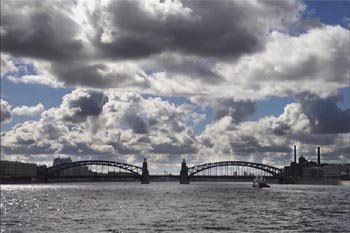SAINTS, MYSTICS AND VILLAINS OF PETERSBURG
MYSTICAL PETERSBURG
CITY LEGENDS
Legends of names of the city parts - Ohta

Legend say: During visiting of shipbuilding shipyard on the right coast of Neva Peter I, passing on one of streets of the Sailor's Sloboda (large village), has suddenly failed almost on a belt in a dirt.
Returned to Petersburg and telling about it in a circle of relatives, he half in jest, half-seriously exclaimed: "Oh, that party has bothered me!"
The phrase has been picked up, and its part has turned to own name of the whole area. But some researchers assume that "Okhta" is the izhora-Finnish word meaning "decline", "West".
Researchers translate the name of the river of Ohta as "the small Bear river".
Anyway, the history of this toponim counts much more time, rather than the history of Petersburg.
Ohta - a place, whence Petersburg began. The settlement history goes back to age-old times when on an ancient trading way "from the Varangian in Greeks" Novgorod people have built one of two sentry posts.
The place has appeared convenient for a review and was not flooded during frequent flooding.
However "at summer 6808 (1300 year), - as testifies the Sofia annals, - came from Zamorija twist (Swedes) settled in a great force in the river Neva... And ... named its earths Venets (Landscrona)".
In 1301 Alexander Nevsky son, Andrey, has won this important strategic cape from Swedes. Only through two and a half century, during Livonsky war, Swedes return again these earths to themselves.
On coast of Okhta they erect a seaport of Nien and a fortress for its protection - Nienschanz. In the night from April, 30th for May, 1st, 1703 Russian armies under command of general admiral Apraksin seize a fortress and destroy it to the basis.
The first stone in the basis of Petersburg could be put here. But the place was not pleasant to Peter.
"It is small, far from the sea and it is not much strong from nature", - he has written down in private "Magazine". So that the city has been put on the Hare island, in a mouth of Neva.
But in 1711 the city has stepped over Fontanka and has directed upstream Neva to the east.
Under the direction of Alexander Kikin Smolny court yard was under construction, and in 1720 there are the first large villages built in Okhta.
The city has returned to the source. But even long two centuries the life and building on Okhta have been noted by lines of provinciality and isolation.
Only with input in a system of the Bolysheohtinsky bridge a life on Ohta became more active.
Source: Three centuries of St.Petersburg: Encyclopaedia